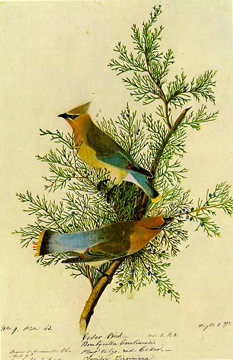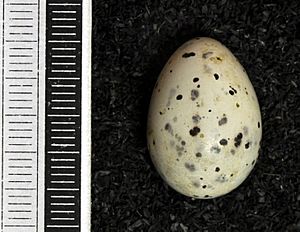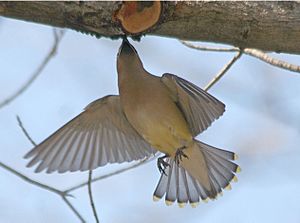Cedar waxwing facts for kids
Quick facts for kids Cedar waxwing |
|
|---|---|
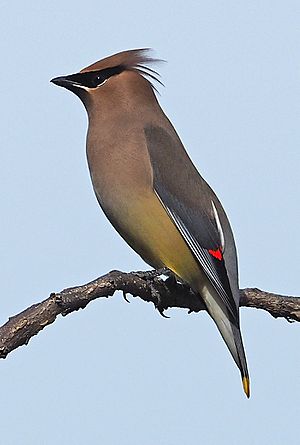 |
|
| Cedar waxwing in Virginia, USA | |
| Conservation status | |
| Scientific classification | |
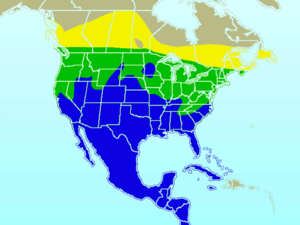 |
|
| Cedar waxwing range Breeding range Year-round range Wintering range |
|
| Synonyms | |
|
The cedar waxwing (Bombycilla cedrorum) is a beautiful bird that belongs to the waxwing family. These birds are medium-sized and are mostly brown, gray, and yellow. They get their name from the special wax-like tips on their wings.
Cedar waxwings live in North and Central America. They spend their summers in open wooded areas in southern Canada. When winter comes, they fly south to the United States, Central America, and even parts of South America. Their favorite foods include cedar cones, fruits, and insects. Good news! The cedar waxwing is not an endangered species.
The scientific name Bombycilla comes from old words meaning "silk" and "tail." This describes their super soft feathers, like silk! The second part of their name, cedrorum, is Latin for "of the cedars," because they love cedar trees.
Contents
All About the Cedar Waxwing
What Do Cedar Waxwings Look Like?
Cedar waxwings are medium-sized birds. They are about 6 to 7 inches (15 to 18 cm) long and weigh around 1 ounce (30 grams). Their wings can spread out from 8.7 to 11.8 inches (22 to 30 cm).
These birds have silky, shiny feathers that are brown, gray, and lemon-yellow. They have a small crest on their head that often lies flat. A cool feature is their black mask around their eyes, which has a thin white border.
The most unique part of their look is the small, red, wax-like drops on the tips of their wing feathers. These drops are very bright and look like tiny pieces of sealing wax! Their tail usually has a yellow or orange tip. If they eat certain berries, like those from honeysuckle plants, their tail tips can be a darker orange.
Young waxwings look a bit different. They have streaks on their throat and sides, and they often don't have the black mask that adult birds have. Both male and female cedar waxwings look very similar.
How Do Cedar Waxwings Fly?
Cedar waxwings are strong flyers. When a group of them flies together, they move in a direct way, almost like a flock of small European starlings. They can fly at speeds of about 40 kilometers per hour (25 mph) and reach heights of up to 610 meters (2,000 feet).
People sometimes call cedar waxwings by other names, like southern waxwing, Canada robin, cedar bird, or cherry bird. The oldest cedar waxwing ever recorded lived to be eight years and two months old!
What Sounds Do They Make?
Cedar waxwings make two main sounds. One is a very high-pitched whistle. The other is a buzzy trill that lasts about half a second. You might hear it as "see" or "sree." They often call out, especially when they are flying.
Where Do Cedar Waxwings Live?
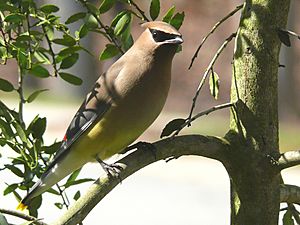
Cedar waxwings like to live in trees at the edge of forests or in open wooded areas. They especially like places where they can find lots of berries and water. You can often spot them in trees that have fruit.
These birds love the sound of running water. They enjoy bathing and drinking from shallow streams. In towns and cities, you might find them in parks with well-spaced trees, golf courses, or gardens. They look for places with berry bushes and a nearby water source like a fountain or birdbath.
Outside of the breeding season, cedar waxwings often gather in huge groups, sometimes with hundreds of birds! They don't stay in one place for long. They move around a lot, especially in winter, looking for food. Most of them fly south to the United States and even northern South America for the colder months. If there aren't enough berries in one area, they will move in large numbers to find more.
Sometimes, a few cedar waxwings have even been seen in western Europe, including Great Britain. It's rare, but it happens! Sometimes, Bohemian waxwings, which are related to cedar waxwings, will join their large winter flocks.
Cedar Waxwing Habits
Cedar waxwings are very social birds. You'll see them in flocks all year round. They don't protect a specific territory. Instead, they move from place to place to find the best berry supplies. They will even groom each other, which means they help clean each other's feathers!
How Do Cedar Waxwings Raise Their Young?
The mating season for cedar waxwings starts in late spring and lasts through the summer. The male bird will do a special "hopping dance" to impress the female. If she likes him, she'll hop back!
During their courtship, the male and female will sit together. They might pass small things back and forth, like flower petals or an insect. Sometimes, they even gently rub their beaks together.
The female waxwing builds a loose, cup-shaped nest using grass and twigs. She lines it with softer materials. The nest is usually built on a tree branch, about 6 to 20 feet (2 to 6 meters) above the ground. It takes her about five or six days to build the nest, making up to 2,500 trips! Sometimes, she might even take nest material from other birds' nests to save time.
She usually lays 5 or 6 oval-shaped eggs. The eggs are smooth and can be light gray or bluish-gray with dark brown or grayish-brown spots. The female sits on the eggs for 11 to 13 days to keep them warm. Both parents help build the nest and feed the baby birds. They usually have one or two groups of babies each mating season. The young birds leave the nest about 14 to 18 days after they hatch.
What Do Cedar Waxwings Eat?
Cedar waxwings love to eat berries and sweet fruit all year long. They enjoy berries from plants like dogwood, serviceberry, cedar, juniper, hawthorn, and winterberry. During the breeding season, insects become a very important part of their diet.
They are especially fond of the small cones from the eastern redcedar tree, which is how they got their common name. They swallow berries whole! Sometimes, they fly over water to catch insects in the air.
Cedar waxwings can sometimes cause problems for fruit farmers because they eat so much fruit in large groups.
Here's a cool fact: If a twig has a bunch of berries that only one bird can reach at a time, the waxwings in the flock might line up. Then, they pass the berries down the line from beak to beak so that everyone gets a turn to eat!
Sometimes, cedar waxwings eat fruit that is very ripe and has started to ferment. This can make the birds a little dizzy or "tipsy"!
Are Cedar Waxwings Endangered?
The cedar waxwing is listed as "Least Concern" on the IUCN Red List of Endangered Species. This means they are not currently at risk of disappearing. Their numbers are actually growing in many areas. This is partly because old fields are turning back into forests and shrublands. Also, people are planting more fruiting trees, like mountain ash, in their yards and parks.
However, cedar waxwings can sometimes fly into windows. They can also get hit by cars when they are looking for food along roadsides.
See also
 In Spanish: Ampelis americano para niños
In Spanish: Ampelis americano para niños



